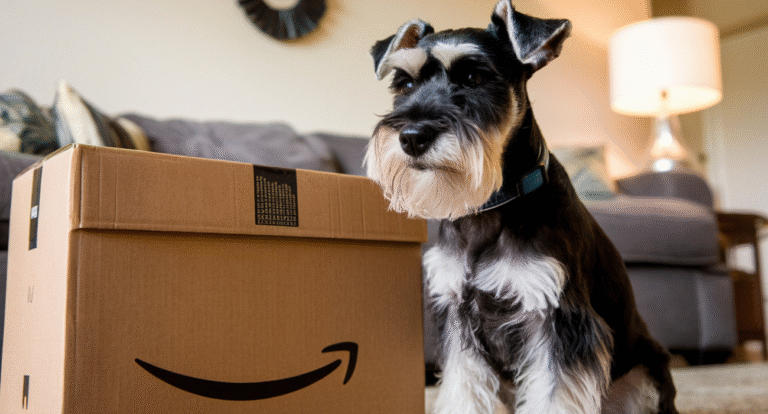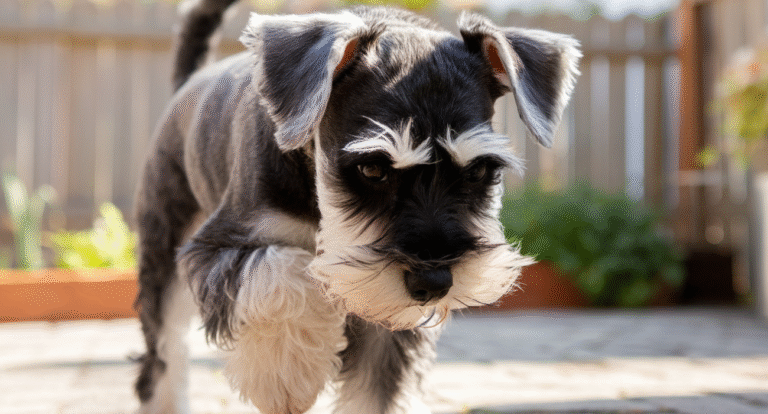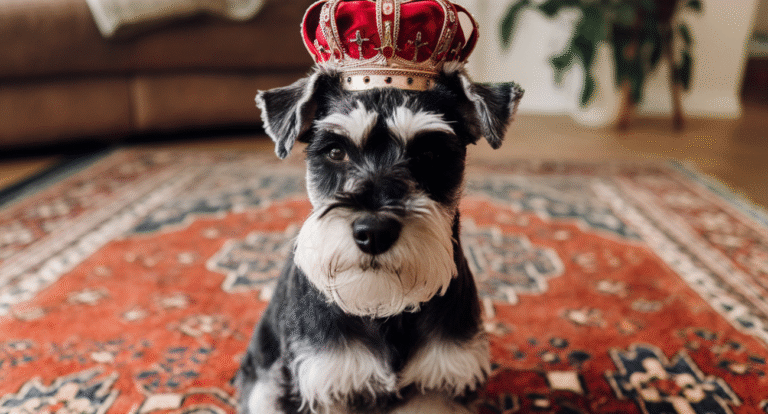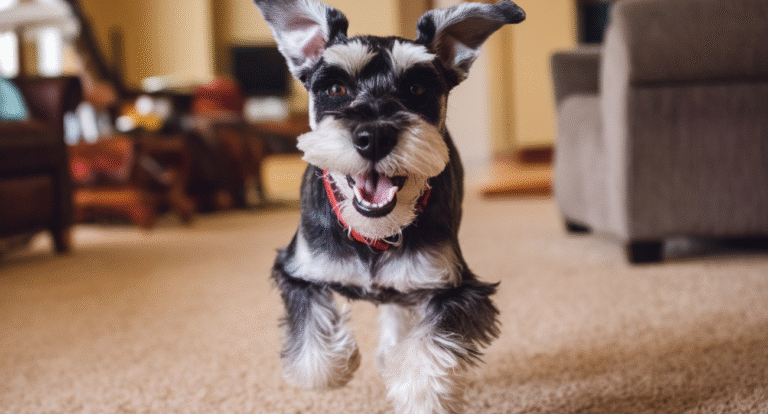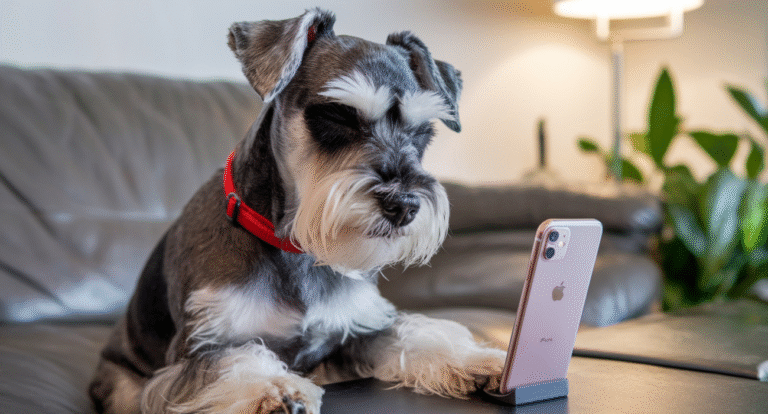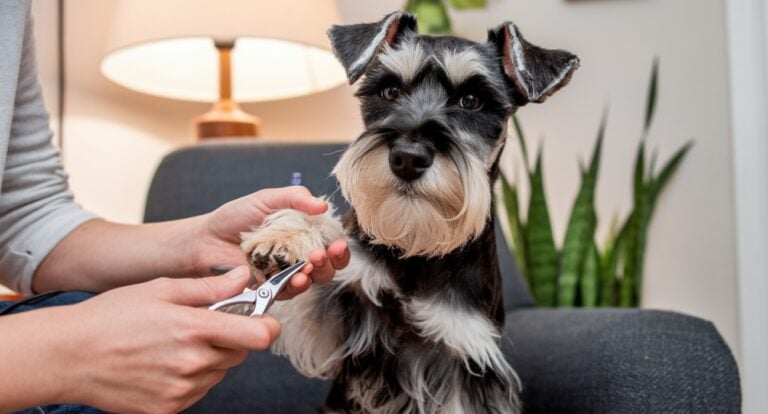Your home might look safe, but these everyday items could be dangerous for your Mini Schnauzer. Check this list now to puppy-proof like a pro and keep your little explorer out of trouble!
There’s something absolutely hilarious about watching a twelve-pound dog approach the world with the confidence of a lion tamer. Miniature schnauzers possess this unique combination of sophistication and chaos that keeps their families perpetually entertained and occasionally terrified.
One moment they’re sitting regally by your side, looking like they’re contemplating the meaning of life, and the next they’re attempting to wrestle a houseplant into submission or conducting a thorough “quality control” inspection of your kitchen trash. This bold personality trait that makes them such wonderful companions also happens to be the same trait that can land them in trouble faster than you can say “drop it.”
The Great Indoor Safari: Room by Room Reconnaissance
Kitchen Catastrophes: Where Culinary Dreams Become Canine Nightmares
The kitchen represents the ultimate paradox for schnauzer owners. It’s simultaneously the heart of the home and a potential minefield of dangers disguised as everyday conveniences. Your schnauzer’s nose, which is roughly 40 times more sensitive than your own, turns this space into a sensory overload that’s impossible to resist.
Chocolate and the Forbidden Feast
Every schnauzer owner learns this lesson eventually: chocolate isn’t just unhealthy for dogs, it’s genuinely toxic. The compound theobromine, which humans metabolize easily, can cause serious poisoning in our four-legged friends. Dark chocolate and baking chocolate pose the greatest threat, but even milk chocolate can cause problems for a curious schnauzer who manages to snag a few squares.
The moment your schnauzer’s eyes lock onto that fallen piece of chocolate, time seems to slow down. You’re diving across the kitchen like an action hero, they’re lunging forward with Olympic-level determination, and somewhere in the background, dramatic music should probably be playing.
Onions, garlic, grapes, and raisins round out the list of common kitchen toxins. The scary part? Many of these items are so integrated into our daily cooking that we barely think twice about them. That onion skin that fell to the floor, those raisins that rolled off the counter, or that piece of garlic bread your dinner guest accidentally dropped could all spell trouble.
Trash Can Treasure Hunts
To understand the appeal of your kitchen trash can, you need to think like a schnauzer. Imagine a container filled with the most interesting smells you’ve encountered all day, mixed together in one convenient location. Add some mystery packaging, strange textures, and the thrill of the forbidden, and you’ve got yourself a doggy casino jackpot.
The dangers here extend beyond spoiled food. Chicken bones can splinter and cause internal damage, food wrappers can create choking hazards or intestinal blockages, and even seemingly harmless items like corn cobs can cause serious digestive problems.
| Kitchen Hazard | Risk Level | Immediate Action |
|---|---|---|
| Chocolate | EXTREME | Contact vet immediately |
| Onions/Garlic | HIGH | Monitor symptoms, call vet |
| Chicken Bones | HIGH | Remove fragments, watch for distress |
| Food Wrappers | MEDIUM | Induce vomiting only if instructed by vet |
| Grapes/Raisins | EXTREME | Emergency veterinary care |
Living Room Landmines: Where Relaxation Meets Chaos
Your living room should be a sanctuary of comfort and relaxation. Unfortunately, your schnauzer sees it as an interactive playground filled with fascinating textures, interesting smells, and plenty of items that seem specifically designed for investigation.
The Electrical Cord Conundrum
Those tangles of wires behind your entertainment center aren’t just unsightly; they’re potential death traps for a teething puppy or a bored adult schnauzer. Electrical cords have this terrible combination of being perfectly chewable and absolutely dangerous. The rubber coating feels satisfying to bite, but underneath lies enough electrical current to cause burns, shock, or worse.
Modern homes are electrical mazes. Between phone chargers, lamp cords, television cables, and computer wires, the average living room contains dozens of potential hazards. Cord covers and cable management systems aren’t just organizational tools; they’re essential safety equipment when you share your space with a curious schnauzer.
Small Object Roulette
Schnauzers approach small objects with the enthusiasm of treasure hunters. Coins become mysterious metal discs worth investigating, buttons transform into interesting chew toys, and small toy pieces turn into impromptu snacks. The “if it fits in their mouth, it’s fair game” rule applies to practically everything in your living room.
The sound of tiny paws scampering across hardwood floors, followed by sudden silence, is every schnauzer parent’s signal to investigate immediately. That silence usually means they’ve found something fascinating, and fascinating rarely equals safe.
Bathroom Booby Traps: Where Hygiene Meets Hazard
Bathrooms present unique challenges because they combine chemicals, medications, and small spaces in ways that create perfect storms for curious dogs.
Chemical Warfare in Miniature
Under your bathroom sink lies a collection of substances that could rival any chemistry lab. Toilet bowl cleaners, bleach, drain uncloggers, and general bathroom cleaners all contain chemicals that can cause serious harm if ingested or even inhaled in large quantities. Schnauzers, with their determined investigative nature, have been known to nose their way into cabinet spaces that seem impossible to access.
The Medication Mishap
Perhaps no household hazard is more dangerous than human medications falling into canine mouths. A single dropped pill can represent a lethal dose for a small dog. Pain relievers like ibuprofen, prescription medications, and even seemingly harmless vitamins can cause organ failure, seizures, or death in dogs.
Bedroom Blunders: Where Rest Becomes Risk
Bedrooms feel like safe spaces, but they harbor their own unique set of schnauzer hazards.
Laundry Day Disasters
That innocent sock lying on your bedroom floor represents a genuine threat to your schnauzer’s digestive system. Dogs don’t discriminate between edible and inedible when something smells interesting, and clothing items can create serious intestinal blockages that require emergency surgery.
Socks are particular culprits because their size and texture make them appealing chew toys that can easily be swallowed. Underwear, small shirts, and even shoelaces have all been known to cause problems for dogs who mistake them for elaborate chew toys.
Aromatic Dangers
Essential oils, scented candles, and air fresheners create pleasant atmospheres for humans but can cause respiratory problems for sensitive schnauzer noses. Some essential oils are particularly toxic to dogs, including tea tree oil, eucalyptus, and certain citrus oils.
Your schnauzer’s idea of “helping” with laundry usually involves redistributing clean clothes around the house, conducting thorough smell tests on everything, and occasionally deciding that your favorite shirt would make an excellent addition to their toy collection.
Backyard Battlegrounds: Where Nature Becomes the Enemy
Garden Warfare
Your beautifully landscaped backyard might look like paradise, but it could be hiding some serious threats. Lilies, azaleas, daffodils, tulips, and sago palms are just a few common landscaping plants that can cause everything from mild stomach upset to organ failure in dogs.
Schnauzers are natural diggers and explorers, which means they’re likely to come into contact with plants in ways you might not expect. They might dig up bulbs, chew on fallen leaves, or even roll around in areas where toxic plants have been growing.
Chemical Lawn Care Complications
That perfectly manicured lawn requires regular treatments with fertilizers, pesticides, and herbicides. While these products make your grass look magazine-worthy, they can be dangerous for dogs who walk on treated areas, lick their paws afterward, or drink from puddles that contain chemical runoff.
Schnauzer-Proofing Your Palace
Creating a truly safe environment for your miniature schnauzer requires thinking like a combination of a safety inspector and a curious dog. Walk through each room at schnauzer eye level. What would be interesting to investigate? What could be reached by jumping, climbing, or particularly determined digging?
Investment in Safety Equipment
Cabinet locks, cord covers, and dog-proof trash cans aren’t just suggestions; they’re essential equipment. The cost of these safety measures pales in comparison to emergency veterinary bills or the emotional trauma of losing a beloved pet to a preventable accident.
Training and Supervision
The best safety equipment is a well-trained dog combined with attentive supervision. Teaching solid “leave it” and “drop it” commands can literally save your schnauzer’s life. These commands need to be practiced regularly and reinforced consistently.
The Adventure Continues Safely
Your miniature schnauzer’s bold personality and fearless curiosity are part of what makes them such incredible companions. They approach the world with enthusiasm that’s both inspiring and occasionally terrifying. By understanding the common household hazards and taking appropriate precautions, you can let your schnauzer maintain their adventurous spirit while keeping them safe from harm. After all, the best adventures are the ones where everyone makes it home safely for dinner and belly rubs.

